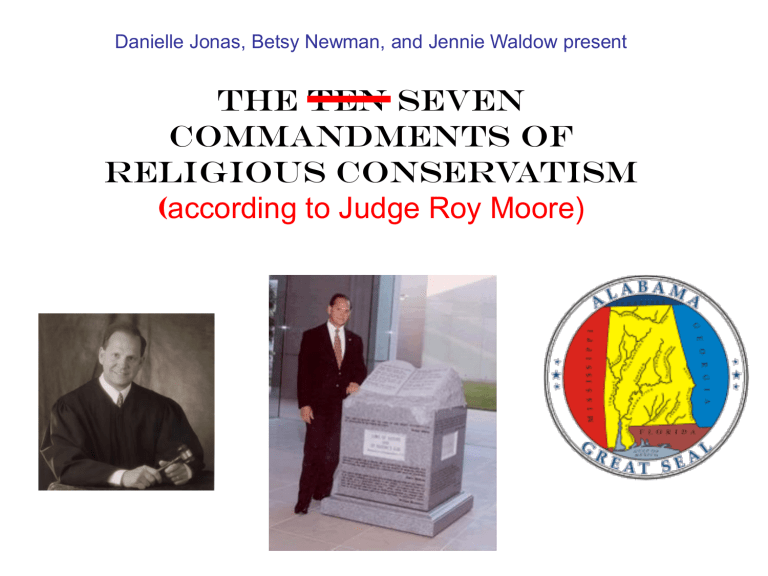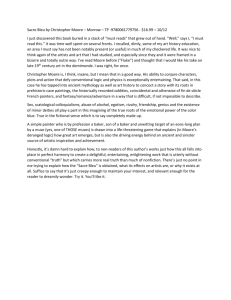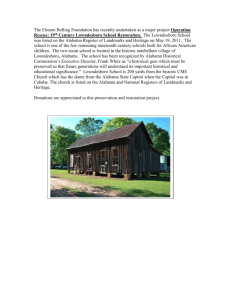Commandment I - Cloudfront.net

Danielle Jonas, Betsy Newman, and Jennie Waldow present
The Ten seven
Commandments of religious conservatism
( according to Judge Roy Moore)
Commandment I:
Thou shalt install a ten commandments monument
Judge Roy Moore and his monument
• In 2001, Judge Roy Moore, the chief justice of the Alabama
Supreme Court, installed a 5,280-pound monument of the Ten
Commandments in the rotunda of Alabama’s state judicial building.
• Obviously, this was a controversial move. Moore defended his actions, stating that he had a First Amendment right to
“acknowledge God” as the “moral foundation of law.”
Commandment II:
Thou shalt protest the removal of the ten commandments monument, even if that means losing your job
Judge Roy Moore and his monument
• There was a lawsuit, and US District Judge Myron Thompson ruled that
Moore had violated the Establishment Clause of the First Amendment.
Thompson wrote in his opinion that Moore had created “a religious sanctuary within the wall of a courthouse.”
• Moore refused to remove the monument, and in 2003, he was removed from his post as Chief Justice of the Alabama Supreme Court.
• Moore may have been an Alabama Supreme Court judge, but
Thompson’s position on the US District Court was higher than Moore’s position. Federal courts may rule on the decisions of state courts as long as, 1) the case has gone to the highest state court already, and 2) the issue at hand concerns the federal government, such as constitutional issues.
Roy Moore
Myron Thompson
What is the debate over depicting the Ten
Commandments in government in the first place? Why is it so problematic?
• The debate is not over whether United States citizens have the right to have a religion and practice it, but rather over their right to publicly acknowledge God. The First Amendment of the United States
Constitution mandates that government "shall make no law respecting the establishment of religion." Since the Framers founded the
Constitution on religious equality, it does not seem constitutional to display the Ten Commandments, the sacred principles of Jews and
Christians, in public buildings. However, Roy Moore, the former chief justice of the Alabama Supreme Court, is desperately trying to transform history in an attempt to "acknowledge God as the moral foundation of law."
And what does the Alabama Constitution say about all of this?
• According to an editorial by University of Alabama School of
Law professor Bryan K. Fair, "Alabama law is clear. [According to the Alabama state constitution], ‘ No religion shall be established; no preference shall be given by law to any sect or denomination.’ There is no state ’s rights defense for Chief
Justice Roy Moore ’s actions.”
Commandment III:
Thou shalt pursue your goals in a religious state
What does Alabama look like religiously?
• 84% of Alabama residents are Christians; 63% are Protestant, 13% are
Catholic, 1% are Jehovah’s Witnesses, 1% are Latter Day Saints, and
6% are Christian non-denominational
• 1% of Alabama residents are Jewish, 3% belong to other religions, 6% have no religion, and 6% of respondents refused to state their religion.
• According to a 2007 survey, 70 percent of respondents could name all four of the Christian Gospels
• 59 percent of respondents said they had a full understanding of their religion and did not need any additional learning.
•
92 percent said they had some confidence in churches in state
So…what is religion like in the south? And has the issue of religious monuments come up in other states?
• Southern states have a longstanding tradition of supporting states’ rights, leading back to the Virginia and Kentucky Resolutions.
• It was in Tennessee that the debate over teaching evolution in schools first sparked with the 1925 Scopes Monkey trial, and the debate continues today. It is spearheaded by many Southern religious organizations.
• The fact that the monument was put up in Alabama is not surprising;
Southerners tend to be solidly Christian than the country as a whole. In
2001, according to the Religious Identification Survey, 77% of
Americans identified themselves as Christians, compared with the aforementioned 83% of people in Alabama.
• But the issue of religious monuments in public places is not confined to the South. In 2007, the 10th U.S. Circuit Court of Appeals ruled that members of the Summum faith have a right to display their Seven
Aphorisms next to the statues of the Ten Commandments in parks in
Pleasant Grove and Duchesne, Utah.
Our opinion:
Should the residents of Alabama be allowed to express their religious preferences in government spaces?
• The majority of Alabama citizens are religious, and they clearly express a strong belief in religious principles and their importance. Though they certainly have a right to display their religious pride, they should not force their religion on those who do not want to practice it.
Commandment IV:
Thou shalt adhere to the doctrine of states’ rights
States v. federal government
•
Judge Moore believes that his right to express his religion by installing the monument is protected by the First Amendment. He is part of a long Southern states’ rights tradition leading back to the Virginia and Kentucky Resolutions, and he maintains that he has the authority to declare the monument constitutional. He prefers state-centric dual federalism.
• Judge Thompson of the U.S. District Court also believes that he is protecting the
First Amendment by ordering the removal of the monument. Thompson believes that the monument violates the separation of church and state and imposes religion in a violation of the First Amendment. He prefers cooperative federalism.
•
So who is right? Thompson holds a higher position than Moore, and the federal courts may overturn the decisions of state courts in cases concerning the
Constitution. v.
Commandment V:
Thou shalt step lightly around the lemon test
How do the courts determine what is religious and what is not?
• Okay, so you may be a little confused by which religious displays are allowed to be displayed on public property, and which are not . Justices attempt to decide by using the so-called Lemon Test.
• The Lemon Test states that “government actions regarding religious displays violate the Establishment Clause unless the display 1) has a significant secular purpose, 2) does not have the primary effect of advancing or inhibiting religion, and 3) does not foster excessive entanglement between government and religion.”
A few examples of the Lemon Test
bad good
• In County of Allegheny v. ACLU (1989), the Supreme Court ruled that a nativity scene in a county building was unconstitutional because the display included only the nativity scene and poinsettias, with no secular symbols.
• In Lynch v. Donnelly (1984), the Supreme Court ruled that a nativity scene displayed in Pawtucket, Rhode Island, did not violate the
Establishment Clause because it included secular symbols such as
Santa Clause and reindeers. The Court concluded that the Pawtucket display was simply a celebration of the season, and so it was fine.
• Also in Allegheny , the Court ruled that a Pittsburgh display of a giant menorah on public property was constitutional because it also included a 45foot Christmas tree, thus “minimizing the likelihood” that the menorah would be taken as an endorsement of Judiasm.
Commandment VI:
Thou shalt pass the
Constitutional Restoration Act
The Constitution Restoration
Act
• The Constitution Restoration Act was originally drafted in 2004 by
(surprise!) Judge Roy Moore and backed by conservative Republicans.
• It states that the federal judiciary cannot review any case concerning the “acknowledgment of God as the sovereign source of law, liberty, or government.”
• If passed, the Act would severely limit the federal courts’ ability to review “religious liberty” cases.
• Moore explained his support for the Act by saying, “The constitution of every state of the Union acknowledges God and His sovereignty, as do three branches of the federal government. The acknowledgment of God is not a legitimate subject of review by federal courts.”
• The Act got stuck in committee, but getting it passed is is a top priority of many conservative Republican congressmen and women.
Commandment VII:
Thou shalt pass moral legislation
The risks of moral legislation
• Social conservatives believe strongly in the “moral” legislation that they champion. However, their strong beliefs are sometimes seen by the public as zealotry.
• When Judge Roy Moore installed the Ten Commandments monument in his courthouse, he also may have alienated those from religions outside of the Judeo-Christian tradition. Though even Judge Myron
Thompson acknowledged that the Ten Commandments are an important basis for much of United States Law, the law is meant to be impersonal. It cannot support one religion over another.
The Risks of Moral Legislation
• As much as conservatives believe in their cause, anti-moral legislation crusaders believe in theirs. Institutions such as the American Civil
Liberties Union (ACLU) fight hard to block religion-based legislation.
• In addition, many traditional Republicans feel alienated by what they see as the Party’s “hijacking” by the Religious Right. Many
Republicans feel that moral legislation crosses the line between church and state, and they are susceptible to voting for the Democratic Party.
Are there alternatives?
• Many social conservatives see legislation as the best way to get their agenda through.
• On many key issues with a religious bent, such as abortion, going through legislation and the courts is the only way for social conservatives to get what they want.
• For example, Roe v. Wade can only be overturned through the courts, but other legislation banning partial-birth abortion can restrict traditional abortion rights. By using legislation to slowly chip away at many of their “targets”, social conservatives move towards their end goals.








